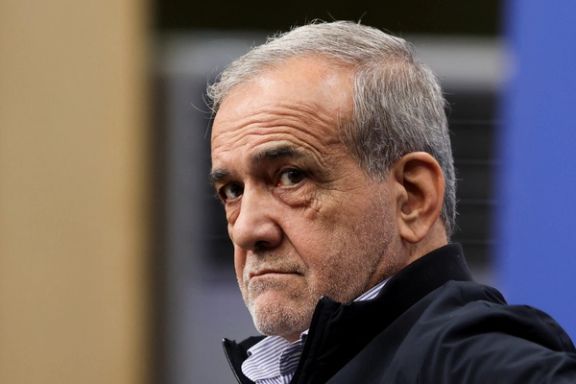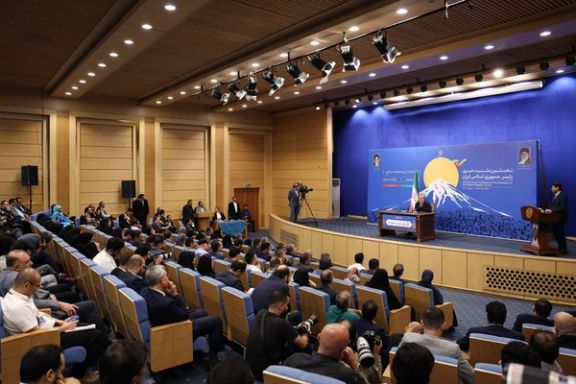Did Pezeshkian impress Iranians with his first press conference?

The immediate reaction on social media to President Masoud Pezeshkian’s belated press conference on Monday was mixed, highlighting the deep divide within Iranian society.

The immediate reaction on social media to President Masoud Pezeshkian’s belated press conference on Monday was mixed, highlighting the deep divide within Iranian society.
Some netizens have viewed the two-and-a-half-hour press conference as a breath of fresh air in Iranian politics. They found Pezeshkian to be more honest and straightforward compared to his predecessor, Ebrahim Raisi, and Saeed Jalili, who narrowly lost to Pezeshkian in the July elections.
Others have noted that when confronted with challenging questions, such as the future of Iran’s relations with the West, Pezeshkian seemed evasive and spoke in vague terms. He often toned down his more assertive statements to avoid controversy or offending critics.
For example, his lengthy response on whether he was open to meeting with the current or a future US president did not offer a clear rejection or acceptance.
Nevertheless, Pezeshkian did go into the offensive mode in a few instances including when he came under attack by the reporter of the ultra-hardline Kayhan newspaper for employing “seditionists” in his government.

Ahmad, a 52-year-old resident of Ekbatan, a middle-class neighborhood in west Tehran, watched the press conference like many other Iranians. “Overall, I was quite pleased,” he said.
“He doesn’t seem to like stirring up trouble with the rest of the world. This alone is enough for those who voted for him to be content even if that doesn’t make their lives any easier now,” Ahmad told Iran International.
“All they would be hearing today if Jalili had been elected would be ‘the enemy’ and ‘enemies’,” he added.
To those who actively boycotted the elections, and refer to themselves as ‘barandaz’ (proponents of regime change), Pezeshkian’s press conference was only another “regime circus”.
His answers, they argued, only reinforced the view that he is merely a puppet of Supreme Leader Ali Khamenei. They suggested that his statements were dictated, indicating that no significant change should be expected in Iran's troubled society.
“All Pezeshkian says is that ‘the system should not be messed with”! In other words, one must be a servant and obedient to Khamenei and move forward when he agrees,” expatriate political commentator Ali Afshari who called Pezeshkian a “nobody” tweeted.
“He has come to say that society should forget about transforming the system and resisting tyranny, and be content with uncertain economic promises,” he wrote.
Hardliners and ultra-hardliners were also displeased with several of Pezeshkian’s statements, including his remarks that “We have no enmity with the US,” and “We don’t intend to export our Revolution.” His insistence on resolving issues with the Financial Action Taskforce (FATF) and pursuing peace with all non-hostile nations also provoked criticism.
They were also infuriated when a female journalist openly told Pezeshkian that she had to make several detours on her way to the press conference to avoid detention by the morality police for not adhering to hijab regulations.
“Do they still harass [women]?” Pezeshkian asked her. “They weren’t supposed to do it anymore. We will follow up on this so they won’t harass you anymore,” he said good-humoredly when he received an affirmative response. His remarks drew applause from some of those present.
As he often does, Pezeshkian spoke in a modest tone throughout the press conference, often disregarding standard protocols. He made a few gaffes, such as referring to Russia as the Soviet Union while discussing the Ukraine War, and included several jokes to elicit laughter from the audience.
As usual, he also recited verses from the Quran and sections from the sermons of the first Shia imam, Imam Ali, in Arabic when responding to some questions. This practice has been criticized by some Iranians as being overly performative and not suited to presidential discourse.
The stage for the press conference to which around 300 domestic and international media representatives and photojournalists had been invited was very different from similar events in the past.
The president sat at a desk in front of a large background banner with the image of the iconic, snow-clad Mount Damavand and the sun rising from behind it in its center and the images of the current Supreme Leader and the founder of the Islamic Republic, Ayatollah Ruhollah Khomeini on either side at the top.
“I pledge my life to make my promises come true,” it read on one side of the banner. This is a quotation from Imam Ali whose shrine in Iraq Pezeshkian visited last week. Under it, two slogans were printed in large letters: “Reforming Governance” and “Returning to the People”.